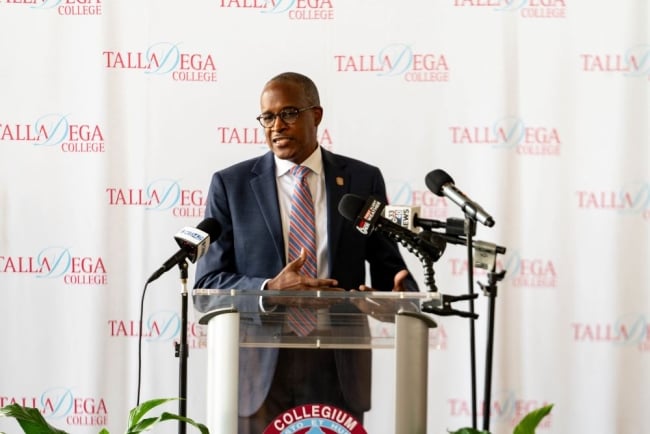You have /5 articles left.
Sign up for a free account or log in.

Walter Kimbrough, interim president of Talladega College, spoke of plans to combat financial challenges in a State of the College address.
Talladega College
In a candid State of the College address on Thursday, Talladega College leaders discussed the plans underway to “course correct” the financially troubled institution.
Enrollment at the college has fallen by about 24 percent over the last few years, mirroring trends faced by other small, private institutions, said interim president Walter Kimbrough.
“Higher education had a dip in enrollment for a decade straight until last year … So, that’s been a challenge for all of higher education, and Talladega was not immune to that challenge,” he said in the address, noting that the historically Black institution depends heavily on tuition dollars.
Talladega is also in debt. It’s currently working on making up delayed payments to vendors, said Board of Directors chairwoman Rica Lewis-Payton. (She declined to say how much money the college owes but described it as a “significant” amount.)
The college caused an uproar among faculty members in May when it failed to make payroll. The president at the time, Gregory Vincent, resigned shortly after. Students’ financial aid refund checks were also delayed, though both issues have since been resolved.
Getting students their refunds was a “top-of-the-list” priority, said Lewis-Payton, and a payroll delay “just should not happen.” She said her goal is for the college to build up an endowment so it doesn’t fall into similar ruts in the future during leaner enrollment years.
“Employees work too hard for us not to make the payroll,” she said.
The college’s former chief financial officer, Sama Mondeh, resigned last week, which Lewis-Payton called a “mutual decision.” She said the college has since found a replacement. College leaders are also looking for a firm to conduct a forensic audit, in addition to its regular annual audits, to take a “deeper dive” into how the college has been spending its funds.
“We’re still getting to the bottom of what the dollars were used for when different from what they were intended for,” she said.
Kimbrough added that he’s taking measures to rightsize the institution—he brought payroll costs down from about $1.4 million to $1 million per month by cutting a number of roles, including some contract positions.
“We just had a lot of people. We were just administratively top-heavy—that’s the only way I can put it,” he said.
The college also cut its women’s gymnastics program this summer after only a year. Kimbrough said the sport doesn’t generate revenue and involved expensive flights to compete with other teams across the country.
“It’s a feel-good program, but when you look at the balance sheet, there was no way we could do it and do it successfully,” he said.
More cuts are potentially “on the table,” Lewis-Payton noted, as the college tries to thread the needle between offering sports and other activities that attract students while not spending beyond its means. The college also undertook a tiered reduction of annual salaries for nonfaculty employees making at least $50,000.
Lewis-Payton emphasized this isn’t the first time Talladega has come up against challenges in its 157-year history.
“There were points where … there were concerns about whether or not this institution will remain through all of those ebbs and flows, and we have,” she said. “And we are committed to doing the same thing again.”





